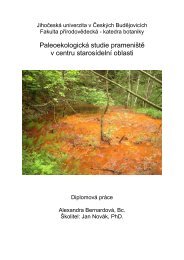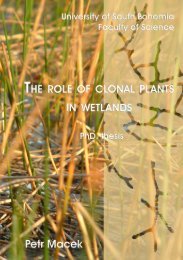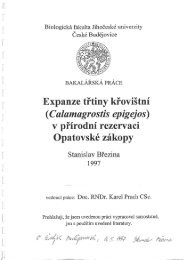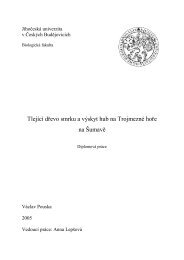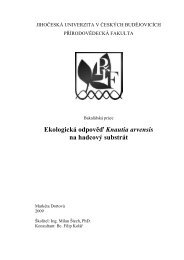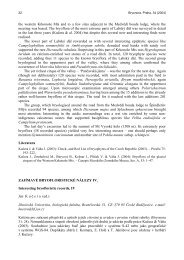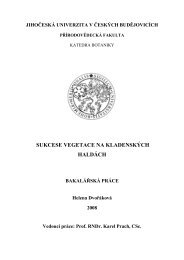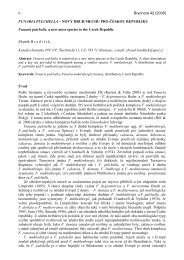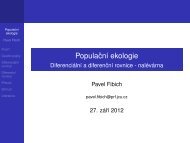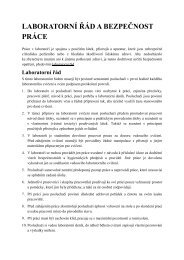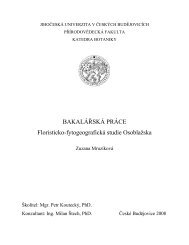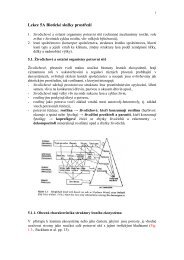NOVÁ LICHENOLOGICKÁ LITERATURA XXI. New lichenological ...
NOVÁ LICHENOLOGICKÁ LITERATURA XXI. New lichenological ...
NOVÁ LICHENOLOGICKÁ LITERATURA XXI. New lichenological ...
You also want an ePaper? Increase the reach of your titles
YUMPU automatically turns print PDFs into web optimized ePapers that Google loves.
56 Bryonora 51 (2013)<br />
Orock E. A., Leavitt S. D., Fonge B. A., St. Clair L. L. & Lumbsch H. T. (2012): DNA-based<br />
identification of lichen-forming fungi: can publicly available sequence databases aid in<br />
lichen diversity inventories of Mount Cameroon (West Africa)? – Lichenologist 44: 833–<br />
839.<br />
Osyczka P. (2012): The lichens of Cladonia, ‘supergroup’ Perviae, in Poland. – Herzogia 25:<br />
15–30.<br />
Otte V. (2012): The value of larch (Larix Mill.) plantations for the protection of threatened<br />
lichens in southern East Germany and adjacent areas. – In: Lipnicki L. [ed.], Lichen<br />
protection – protected lichen species, p. 333, Gorzów Wlkp.: Sonar Literacki.<br />
Otte V. & Jeremies M. (2011): Die Flechten des Baruther Schafberges und der Dubrauker<br />
Horken. – Berichte der Naturforschenden Gesellschaft der Oberlausitz, Supplement zu Band<br />
18: 95–96.<br />
Oukarroum A., Strasser R. J. & Schansker G. (2012): Heat stress and the photosynthetic<br />
electron transport chain of the lichen Parmelina tiliacea (Hoffm.) Ach. in the dry and the<br />
wet state: differences and similarities with the heat stress response of higher plants. –<br />
Photosynthesis Research 111: 303–314.<br />
Ozimec S. (2011): Diversity and ecology of epiphytic and terricolous lichen mycota in Gorski<br />
kotar and Kvarner littoral (Croatia). – Acta Biologica Slovenica 54: 15–41.<br />
Pankratov T. A. (2012): Acidobacteria in microbial communities of the bog and tundra lichens.<br />
– Microbiology 81: 51–58.<br />
Paoli L. et al. (2012): Long-term biological monitoring of environmental quality around a solid<br />
waste landfill assessed with lichens. – Environmental Pollution 161: 70–75.<br />
Parnmen S., Lücking R. & Lumbsch H. T. (2012): Phylogenetic classification at generic level<br />
in the absence of distinct phylogenetic patterns of phenotypical variation: a case study in<br />
Graphidaceae (Ascomycota). – PLoS ONE 7(12): e51392.<br />
Parnmen S. et al. (2012): Using phylogenetic and coalescent methods to understand the species<br />
diversity in the Cladia aggregata complex (Ascomycota, Lecanorales). – PLoS ONE 7(12):<br />
e52245.<br />
Partl A. (2011): Lichen flora of Žumberak-Samoborsko gorje Nature Park, NW Croatia. – Acta<br />
Botanica Croatica 70: 99–107.<br />
Paukov A. G. & Teptina A. Yu. (2012): <strong>New</strong> records of lichens from Middle Urals, Russia. –<br />
Folia Cryptogamica Estonica 49: 39–43.<br />
Pérez-Ortega S. et al. (2012): Extreme phenotypic variation in Cetraria aculeata (lichenized<br />
Ascomycota): adaptation or incidental modification?. – Annals of Botany 109: 1133–1148.<br />
Pérez-Ortega S., Ortiz-Álvarez R., Green T. G. A. & de los Ríos A. (2012): Lichen myco- and<br />
photobiont diversity and their relationships at the edge of life (McMurdo Dry Valleys,<br />
Antarctica). – FEMS Microbiology Ecology 82: 429–448.<br />
Peršoh D. & Rambold G. (2012): Lichen-associated fungi of the Letharietum vulpinae. –<br />
Mycological Progress 11: 753–760.<br />
Pinho P. et al. (2012): Lichen functional groups as ecological indicators of the effects of landuse<br />
in Mediterranean ecosystems. – Ecological Indicators 15: 36–42.<br />
Pino-Bodas R., Ahti T., Stenroos S., Martín M. P. & Burgaz A. R. (2012): Cladonia conista<br />
and C. humilis (Cladoniaceae) are different species. – Bibliotheca Lichenologica 108: 161–<br />
176.<br />
Pino-Bodas R., Burgaz A. R., Martín M. P. & Lumbsch H. T. (2012): Species delimitations in<br />
the Cladonia cariosa group (Cladoniaceae, Ascomycota). – Lichenologist 44: 121–135.



